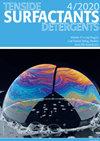Transition from a foam-like to an onion-like nanostructure in water-rich L3 phases
IF 1.2
4区 工程技术
Q4 CHEMISTRY, APPLIED
引用次数: 0
Abstract
Abstract In dilute water-surfactant systems L 3 phases are found in which bilayers interconnect to form a sample-spanning sponge-like structure. From our previous study of the system water/NaCl-AOT (sodium bis(2-ethylhexyl) sulfosuccinate) we know that a transition of this sponge-like structure to an oil-continuous foam-like structure occurs upon addition of minute amounts of oil (about 3 wt%, α = 0.03) in the L 3 channel at a constant surfactant mass fraction of γ = 0.15 and T = 25 °C. The aim of the present study was to verify if the same transition occurs at γ = 0.25. To achieve this goal, we determined the relevant part of the phase diagram and studied the electrical conductivities and viscosities within the narrow one-phase L 3 channel. Although the electrical conductivities and viscosities change qualitatively like those observed at γ = 0.15 we did not observe a sponge-like structure at γ = 0.25 in the oil-free system ( α = 0) with freeze-fracture electron microscopy (FFEM) and freeze fracture direct imaging (FFDI). Together with the FFEM/FFDI images and SANS/SAXS curves we provide experimental evidence for a structural transition with decreasing oil content from a thermodynamically stable foam-like to a thermodynamically stable onion-like nanostructure at γ = 0.25 rather than to a sponge-like structure as is the case at γ = 0.15.在富水L3相中从泡沫状纳米结构过渡到洋葱状纳米结构
摘要在稀水-表面活性剂体系中,发现了l3相,其中双层相互连接形成跨样品的海绵状结构。从我们之前对水/NaCl-AOT(二(2-乙基己基)琥珀酸钠)体系的研究中我们知道,在表面活性剂质量分数为γ = 0.15和温度为25℃的恒定条件下,在l3通道中加入微量的油(约3 wt%, α = 0.03),这种海绵状结构就会转变为油连续泡沫状结构。本研究的目的是验证在γ = 0.25时是否发生同样的转变。为了实现这一目标,我们确定了相图的相关部分,并研究了狭窄的单相l3通道内的电导率和粘度。尽管电导率和粘度的定性变化与γ = 0.15时相似,但在无油体系(α = 0)中,冷冻断裂电子显微镜(FFEM)和冷冻断裂直接成像(FFDI)并没有观察到γ = 0.25时的海绵状结构。结合FFEM/FFDI图像和SANS/SAXS曲线,我们提供了实验证据,证明在γ = 0.25时,油含量从热力学稳定的泡沫状纳米结构转变为热力学稳定的洋葱状纳米结构,而不是像γ = 0.15时那样转变为海绵状结构。
本文章由计算机程序翻译,如有差异,请以英文原文为准。
求助全文
约1分钟内获得全文
求助全文
来源期刊

Tenside Surfactants Detergents
工程技术-工程:化工
CiteScore
1.90
自引率
10.00%
发文量
57
审稿时长
3.8 months
期刊介绍:
Tenside Surfactants Detergents offers the most recent results of research and development in all fields of surfactant chemistry, such as: synthesis, analysis, physicochemical properties, new types of surfactants, progress in production processes, application-related problems and environmental behavior. Since 1964 Tenside Surfactants Detergents offers strictly peer-reviewed, high-quality articles by renowned specialists around the world.
 求助内容:
求助内容: 应助结果提醒方式:
应助结果提醒方式:


